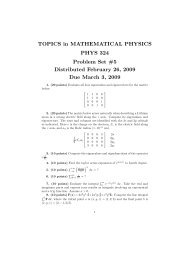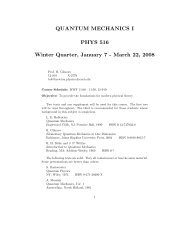[PDF] Problem Set #1
[PDF] Problem Set #1
[PDF] Problem Set #1
You also want an ePaper? Increase the reach of your titles
YUMPU automatically turns print PDFs into web optimized ePapers that Google loves.
QUANTUM MECHANICS IPHYS 516<strong>Problem</strong> <strong>Set</strong> # 1Distributed: Jan. 7, 2011Due: Jan. 17, 2011The Frobenius Method is a classical workhorse for finding solutions of relativelysimple ordinary differential equations. (The link is to the course website:http://www.physics.drexel.edu/~bob/PHYS516_11/Frobenius.pdf).Here are two examples:( d2dr + A 2 r + B )2 r + C R(r) = 0( d2dr 2 + D r 2 + E + F r2 )R(r) = 0The first is a general form for the radial part of the quantum wavefunctionfor a Coulomb potential. The second is a general form for the radial part ofthe quantum wavefunction for a harmonic oscillator potential.1. Use the Frobenius method to determine the quantization condition forsquare-integrable radial functions ∫ ∞0 R 2 (r)dr < ∞:Coulomb: on the coefficients A, B, C;Harmonic Oscillator: on the coefficients D, E, F .2. For the Coulomb problem in three dimensions determine the coefficientsA, B, C in thea. relativistic case (Klein-Gordan Equation)1
. nonrelativistic case (NR Schrödinger Equation).3. Determine the coefficients D, E, F for the nonrelativistic harmonicoscillator ini. one dimensionii. two dimensionsiii. three dimensions4. Compute the energy of an electron (in eV) in the most tightly boundstate about each of these nuclei:Z = 1 Z = 26 Z = 82Proton Iron Nucleus Lead NucleusN.R. Schrödinger Equation −13.58Relativistic Klein-Gordon Eq.In computing the relativistic energy, subtract off the electron rest energymc 2 and enter E − mc 2 in the table above.In this problem, if there are any surprises, explain:a. What?b. Where?c. Why?d. What does it mean?e. What to do about it?5. The expression for the energies of the “relativistic hydrogen atom”derived from the Klein Gordan equation isE =mc 2( ) 2√ α1 +N(α)where N(α) = n + 1 2 + √ (l + 1 2 )2 − α 2 and α is the fine structure constant,α = 1/137.03611 ≃ .007. Here n = 0, 1, 2, ... is the “radial” quantum number2
and l = 0, 1, 2, ... is the orbital angular momentum quantum number. Theprinciple quantum number N (the one you remember from your undergraduatecourse) is N = n + l + 1.a. Expand E in powers of α up to, and including, the sixth degree (useMaple or/and go crazy!). Explain the leading (zeroth order) term. Comparethe second order term (the one containing α 2 ) with the expression for thenonrelativistic energies of the hydrogen atom. Express both in terms of N.Write down the fourth order terms. Express these energies in terms of N andl. These are close to the usual “relativistic corrections” to the nonrelativistichydrogen atom.b. Optional: For a single electron around a nucleus of charge Ze theenergy eigenvalues are obtained from E above by the substitution α → Zα.What happens when Z gets “too big”? How big is “too big”? What do youdo then?3


![[PDF] Problem Set #1](https://img.yumpu.com/51299607/1/500x640/pdf-problem-set-1.jpg)
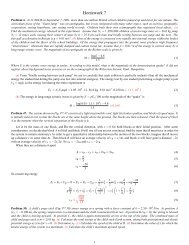
![[PDF] Problem Set #3](https://img.yumpu.com/50150452/1/184x260/pdf-problem-set-3.jpg?quality=85)
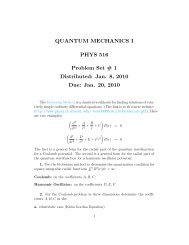
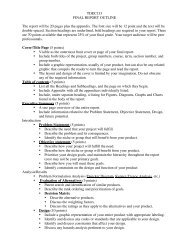
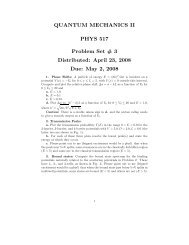
![[PDF] Problem Set #2](https://img.yumpu.com/45468456/1/184x260/pdf-problem-set-2.jpg?quality=85)
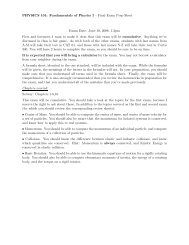
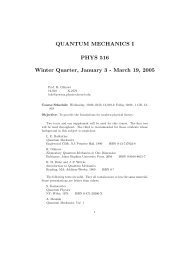
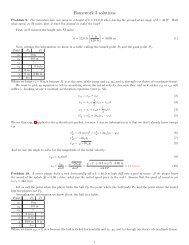
![[PDF] Xiang Liu: Fourier Transform Interferometer](https://img.yumpu.com/39562390/1/190x245/pdf-xiang-liu-fourier-transform-interferometer.jpg?quality=85)
![[PDF] Midterm Template](https://img.yumpu.com/39562028/1/184x260/pdf-midterm-template.jpg?quality=85)

